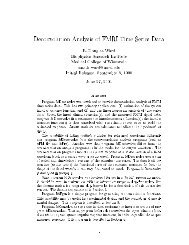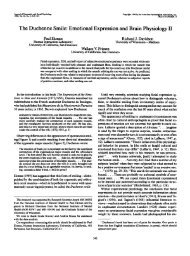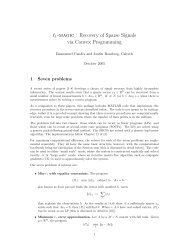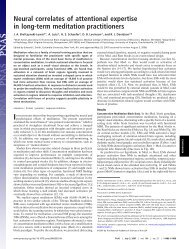Temporal difference models describe higher-order learning in humans
Temporal difference models describe higher-order learning in humans
Temporal difference models describe higher-order learning in humans
You also want an ePaper? Increase the reach of your titles
YUMPU automatically turns print PDFs into web optimized ePapers that Google loves.
letters to nature<br />
duplicates were deleted to obta<strong>in</strong> predictions on the dispensability of the underly<strong>in</strong>g<br />
enzymatic reaction.<br />
Comparison of Mycoplasma and Saccharomyces genomes<br />
We calculated the frequency of non-essential genes <strong>in</strong> the M. genitalium and the<br />
S. cerevisiae genomes (only s<strong>in</strong>gle-copy genes were considered). Gene duplicates were<br />
identified us<strong>in</strong>g a BLAST prote<strong>in</strong> search, with at least 25% am<strong>in</strong>o acid similarity (us<strong>in</strong>g<br />
different thresholds do not affect our results). The list of putative essential Mycoplasma<br />
genes is from ref. 26. We found 1,881 out of 3,003 s<strong>in</strong>gle-copy yeast genes that are nonessential.<br />
This figure is 83 out of 356 genes for Mycoplasma.<br />
Received 14 January; accepted 30 April 2004; doi:10.1038/nature02636.<br />
1. Giaever, G. et al. Functional profil<strong>in</strong>g of the Saccharomyces cerevisiae genome. Nature 418, 387–391<br />
(2002).<br />
2. Forster, J., Famili, I., Fu, P., Palsson, B. O. & Nielsen, J. Genome-scale reconstruction of the<br />
Saccharomyces cerevisiae metabolic network. Genome Res. 13, 244–253 (2003).<br />
3. Famili, I., Forster, J., Nielsen, J. & Palsson, B. O. Saccharomyces cerevisiae phenotypes can be predicted<br />
by us<strong>in</strong>g constra<strong>in</strong>t-based analysis of a genome-scale reconstructed metabolic network. Proc. Natl<br />
Acad. Sci. USA 100, 13134–13139 (2003).<br />
4. Forster, J., Famili, I., Palsson, B. O. & Nielsen, J. Large-scale evaluation of <strong>in</strong> silico gene deletions <strong>in</strong><br />
Saccharomyces cerevisiae. OMICS 7, 193–202 (2003).<br />
5. Segre, D., Vitkup, D. & Church, G. M. Analysis of optimality <strong>in</strong> natural and perturbed metabolic<br />
networks. Proc. Natl Acad. Sci. USA 99, 15112–15117 (2002).<br />
6. Ste<strong>in</strong>metz, L. M. et al. Systematic screen for human disease genes <strong>in</strong> yeast. Nature Genet. 31, 400–404<br />
(2002).<br />
7. Wagner, A. Robustness aga<strong>in</strong>st mutations <strong>in</strong> genetic networks of yeast. Nature Genet. 24, 355–361 (2000).<br />
8. Gu, Z. et al. Role of duplicate genes <strong>in</strong> genetic robustness aga<strong>in</strong>st null mutations. Nature 421, 63–66<br />
(2003).<br />
9. Gu, X. Evolution of duplicate genes versus genetic robustness aga<strong>in</strong>st null mutations. Trends Genet. 19,<br />
354–356 (2003).<br />
10. Stell<strong>in</strong>g, J., Klamt, S., Bettenbrock, K., Schuster, S. & Gilles, E. D. Metabolic network structure<br />
determ<strong>in</strong>es key aspects of functionality and regulation. Nature 420, 190–193 (2002).<br />
11. Pap<strong>in</strong>, J. A., Price, N. D., Wiback, S. J., Fell, D. A. & Palsson, B. O. Metabolic pathways <strong>in</strong> the postgenome<br />
era. Trends Biochem. Sci. 28, 250–258 (2003).<br />
12. Emmerl<strong>in</strong>g, M. et al. Metabolic flux responses to pyruvate k<strong>in</strong>ase knockout <strong>in</strong> Escherichia coli.<br />
J. Bacteriol. 184, 152–164 (2002).<br />
13. Kitami, T. & Nadeau, J. H. Biochemical network<strong>in</strong>g contributes more to genetic buffer<strong>in</strong>g <strong>in</strong> human<br />
and mouse metabolic pathways than does gene duplication. Nature Genet. 32, 191–194 (2002).<br />
14. Pál, C., Papp, B. & Hurst, L. D. Rate of evolution and gene dispensability. Nature 421, 496–497<br />
(2003).<br />
15. Thatcher, J. W., Shaw, J. M. & Dick<strong>in</strong>son, W. J. Marg<strong>in</strong>al fitness contributions of nonessential genes <strong>in</strong><br />
yeast. Proc. Natl Acad. Sci. USA 95, 253–257 (1998).<br />
16. Edwards, J. S. & Palsson, B. O. The Escherichia coli MG1655 <strong>in</strong> silico metabolic genotype: its def<strong>in</strong>ition,<br />
characteristics, and capabilities. Proc. Natl Acad. Sci. USA 97, 5528–5533 (2000).<br />
17. Daran-Lapujade, P. et al. Role of transcriptional regulation <strong>in</strong> controll<strong>in</strong>g fluxes <strong>in</strong> central carbon<br />
metabolism of Saccharomyces cerevisiae: a chemostat culture study. J. Biol. Chem. 279, 9125–9138<br />
(2004).<br />
18. Nakao, M. et al. Genome-scale gene expression analysis and pathway reconstruction <strong>in</strong> KEGG.<br />
Genome Inform. Ser. Workshop Genome Inform. 10, 94–103 (1999).<br />
19. Schill<strong>in</strong>g, C. H., Edwards, J. S., Letscher, D. & Palsson, B. O. Comb<strong>in</strong><strong>in</strong>g pathway analysis with flux<br />
balance analysis for the comprehensive study of metabolic systems. Biotechnol. Bioeng. 71, 286–306<br />
(2000).<br />
20. Wagner, G. P., Booth, G. & Bagheri-Chaichian, H. A population genetic theory of canalization.<br />
Evolution 51, 329–347 (2000).<br />
21. Seoighe, C. & Wolfe, K. H. Yeast genome evolution <strong>in</strong> the post-genome era. Curr. Op<strong>in</strong>. Microbiol. 2,<br />
548–554 (1999).<br />
22. Papp, B., Pal, C. & Hurst, L. D. Dosage sensitivity and the evolution of gene families <strong>in</strong> yeast. Nature<br />
424, 194–197 (2003).<br />
23. Gerdes, S. Y. et al. Experimental determ<strong>in</strong>ation and system level analysis of essential genes <strong>in</strong><br />
Escherichia coli MG1655. J. Bacteriol. 185, 5673–5684 (2003).<br />
24. Kobayashi, K. et al. Essential Bacillus subtilis genes. Proc. Natl Acad. Sci. USA 100, 4678–4683 (2003).<br />
25. Kamath, R. S. et al. Systematic functional analysis of the Caenorhabditis elegans genome us<strong>in</strong>g RNAi.<br />
Nature 421, 231–237 (2003).<br />
26. Hutchison, C. A. et al. Global transposon mutagenesis and a m<strong>in</strong>imal Mycoplasma genome. Science<br />
286, 2165–2169 (1999).<br />
27. Glasner, J. D. et al. ASAP, a systematic annotation package for community analysis of genomes. Nucleic<br />
Acids Res. 31, 147–151 (2003).<br />
28. Altschul, S. F. et al. Gapped BLAST and PSI-BLAST: a new generation of prote<strong>in</strong> database search<br />
programs. Nucleic Acids Res. 25, 3389–3402 (1997).<br />
29. Mewes, H. W. et al. MIPS: a database for genomes and prote<strong>in</strong> sequences. Nucleic Acids Res. 30, 31–34<br />
(2002).<br />
Supplementary Information accompanies the paper on www.nature.com/nature.<br />
Acknowledgements We thank J. Förster and B. Palsson for discussions and provid<strong>in</strong>g<br />
<strong>in</strong>formation on the yeast flux balance model. We also thank J. Glasner for provid<strong>in</strong>g growth data<br />
on the E. coli wild-type stra<strong>in</strong>. B.P. and C.P. were supported by the Hungarian National Research<br />
Grant Foundation (OTKA).<br />
Compet<strong>in</strong>g <strong>in</strong>terests statement The authors declare that they have no compet<strong>in</strong>g f<strong>in</strong>ancial<br />
<strong>in</strong>terests.<br />
Correspondence and requests for materials should be addressed to L.D.H. (l.d.hurst@bath.ac.uk).<br />
664<br />
..............................................................<br />
<strong>Temporal</strong> <strong>difference</strong> <strong>models</strong> <strong>describe</strong><br />
<strong>higher</strong>-<strong>order</strong> <strong>learn<strong>in</strong>g</strong> <strong>in</strong> <strong>humans</strong><br />
Ben Seymour 1 , John P. O’Doherty 1 , Peter Dayan 2 , Mart<strong>in</strong> Koltzenburg 3 ,<br />
Anthony K. Jones 4 , Raymond J. Dolan 1 , Karl J. Friston 1<br />
& Richard S. Frackowiak 1,5<br />
1 Wellcome Department of Imag<strong>in</strong>g Neuroscience, 12 Queen Square, London<br />
WC1N 3BG, UK<br />
2 Gatsby Computational Neuroscience Unit, Alexandra House, 17 Queen Square,<br />
London WC1N 3AR, UK<br />
3 Institute of Child Health, University College London, 30 Guilford St, London<br />
WC1N 1EH, UK<br />
4 University of Manchester Rheumatic Diseases Centre, Hope Hospital, Manchester<br />
M6 8HD, UK<br />
5 Fondazione Santa Lucia, 00179 Rome, Italy<br />
.............................................................................................................................................................................<br />
The ability to use environmental stimuli to predict impend<strong>in</strong>g<br />
harm is critical for survival. Such predictions should be available<br />
as early as they are reliable. In pavlovian condition<strong>in</strong>g, cha<strong>in</strong>s of<br />
successively earlier predictors are studied <strong>in</strong> terms of <strong>higher</strong><strong>order</strong><br />
relationships, and have <strong>in</strong>spired computational theories<br />
such as temporal <strong>difference</strong> <strong>learn<strong>in</strong>g</strong> 1 . However, there is at<br />
present no adequate neurobiological account of how this <strong>learn<strong>in</strong>g</strong><br />
occurs. Here, <strong>in</strong> a functional magnetic resonance imag<strong>in</strong>g<br />
(fMRI) study of <strong>higher</strong>-<strong>order</strong> aversive condition<strong>in</strong>g, we <strong>describe</strong> a<br />
key computational strategy that <strong>humans</strong> use to learn predictions<br />
about pa<strong>in</strong>. We show that neural activity <strong>in</strong> the ventral striatum<br />
and the anterior <strong>in</strong>sula displays a marked correspondence to the<br />
signals for sequential <strong>learn<strong>in</strong>g</strong> predicted by temporal <strong>difference</strong><br />
<strong>models</strong>. This result reveals a flexible aversive <strong>learn<strong>in</strong>g</strong> process<br />
ideally suited to the chang<strong>in</strong>g and uncerta<strong>in</strong> nature of real-world<br />
environments. Taken with exist<strong>in</strong>g data on reward <strong>learn<strong>in</strong>g</strong> 2 ,<br />
our results suggest a critical role for the ventral striatum <strong>in</strong><br />
<strong>in</strong>tegrat<strong>in</strong>g complex appetitive and aversive predictions to coord<strong>in</strong>ate<br />
behaviour.<br />
Substantial evidence <strong>in</strong> <strong>humans</strong> and other animals has outl<strong>in</strong>ed a<br />
network of bra<strong>in</strong> regions <strong>in</strong>volved <strong>in</strong> the prediction of pa<strong>in</strong>ful and<br />
aversive events 3–6 . Most of this work has concentrated on its simplest<br />
realization, namely first-<strong>order</strong> pavlovian fear condition<strong>in</strong>g; however,<br />
the predictions <strong>in</strong> this paradigm are rudimentary, show<strong>in</strong>g<br />
little of the complexities associated with sequences of predictors that<br />
are critical <strong>in</strong> psychological <strong>in</strong>vestigations of prognostication 7 .<br />
These latter studies led to a computational account called temporal<br />
<strong>difference</strong> <strong>learn<strong>in</strong>g</strong> 1,8 , which has close l<strong>in</strong>ks with methods for<br />
prediction, and optimal action selection, <strong>in</strong> eng<strong>in</strong>eer<strong>in</strong>g 9 . When<br />
applied to first-<strong>order</strong> appetitive condition<strong>in</strong>g, temporal <strong>difference</strong><br />
<strong>learn<strong>in</strong>g</strong> provides a compell<strong>in</strong>g account of neurophysiological data,<br />
both with respect to the phasic activity of dopam<strong>in</strong>e neurons <strong>in</strong><br />
animal studies, and with blood-oxygenation-level-dependent<br />
(BOLD) activity <strong>in</strong> human functional neuroimag<strong>in</strong>g studies 10–15 .<br />
However, beyond this simple paradigm, the utility of temporal<br />
<strong>difference</strong> <strong>models</strong> to <strong>describe</strong> <strong>learn<strong>in</strong>g</strong> rema<strong>in</strong>s largely unexplored.<br />
Here we provide a neurobiological <strong>in</strong>vestigation based on aversive<br />
and, importantly, sequential condition<strong>in</strong>g.<br />
We used fMRI to <strong>in</strong>vestigate the pattern of bra<strong>in</strong> responses <strong>in</strong><br />
<strong>humans</strong> dur<strong>in</strong>g a second-<strong>order</strong> pa<strong>in</strong> <strong>learn<strong>in</strong>g</strong> task. Fourteen healthy<br />
subjects were shown two visual cues <strong>in</strong> succession, followed by a<br />
high- or low-<strong>in</strong>tensity pa<strong>in</strong> stimulus delivered to the left hand<br />
(Fig. 1a) (see Methods). Subjects were told that they were perform<strong>in</strong>g<br />
a study of reaction times and were asked to judge whether the<br />
cues appeared on the left or on the right side of a display monitor.<br />
The second cue <strong>in</strong> each sequence was fully predictive of the strength<br />
of the subsequently experienced pa<strong>in</strong>; however, the first cue only<br />
allowed a probabilistic prediction. Thus, <strong>in</strong> a small percentage of<br />
© 2004 Nature Publish<strong>in</strong>g Group<br />
NATURE | VOL 429 | 10 JUNE 2004 | www.nature.com/nature
letters to nature<br />
Figure 1 Experimental design and temporal <strong>difference</strong> model. a, The experimental design<br />
expressed as a Markov cha<strong>in</strong>, giv<strong>in</strong>g four separate trial types. b, <strong>Temporal</strong> <strong>difference</strong><br />
value. As <strong>learn<strong>in</strong>g</strong> proceeds, earlier cues learn to make accurate value predictions (that is,<br />
weighted averages of the f<strong>in</strong>al expected pa<strong>in</strong>). c, <strong>Temporal</strong> <strong>difference</strong> prediction error;<br />
dur<strong>in</strong>g <strong>learn<strong>in</strong>g</strong> the prediction error is transferred to earlier cues as they acquire the<br />
ability to make predictions. In trial types 3 and 4, the substantial change <strong>in</strong> prediction<br />
elicits a large positive or negative prediction error. (For clarity, before and mid-<strong>learn<strong>in</strong>g</strong> are<br />
shown only for trial type 1.)<br />
trials, the expectation evoked by the first cue would be reversed by<br />
the second. This allowed us to study the neural implementation of<br />
both the expectations themselves, and their reversals.<br />
Two important aspects of most accounts of prediction <strong>learn<strong>in</strong>g</strong><br />
are the predictions themselves (termed values) and the errors <strong>in</strong><br />
those predictions 9 . Figure 1b shows the predictions associated with<br />
each of the trial types 1–4. These predictions are calculated and<br />
revised as new stimuli are presented. Figure 1c shows the associated<br />
prediction error. The nature of this signal, which treats ongo<strong>in</strong>g<br />
changes <strong>in</strong> predicted values on an exact par with actual affective<br />
outcomes, has helped to expla<strong>in</strong> data on dopam<strong>in</strong>e cell activity. This<br />
prediction error signal drives <strong>learn<strong>in</strong>g</strong> by specify<strong>in</strong>g how the<br />
predictions should change. In appetitive condition<strong>in</strong>g the dopam<strong>in</strong>e<br />
projection to the ventral striatum is believed to be a critical<br />
substrate for this signal, although apart from theoretical speculations<br />
about opponent process<strong>in</strong>g 16 , the equivalent for aversive<br />
condition<strong>in</strong>g is less clear. As <strong>in</strong> earlier work on appetitive condition<strong>in</strong>g,<br />
we used the temporal <strong>difference</strong> model to generate<br />
regressors based on the values and prediction errors appropriate<br />
to each <strong>in</strong>dividual subject 13 . Statistical parametric mapp<strong>in</strong>g of the<br />
regression coefficients permits identification of regions associated<br />
with, and <strong>in</strong> receipt of, <strong>in</strong>formation about predictions. Indeed, the<br />
temporal <strong>difference</strong> value was (negatively) correlated with the<br />
reaction times across subjects for the high-valued cues<br />
(P , 0.001), even when consider<strong>in</strong>g the second-<strong>order</strong> cue alone<br />
(P , 0.01). This result provides strong evidence that behavioural<br />
re<strong>in</strong>forcement occurs <strong>in</strong> a manner consistent with the temporal<br />
<strong>difference</strong> model.<br />
The prediction error was highly correlated with activity <strong>in</strong> both<br />
the right and the left ventral putamen (Fig. 2). Correlations were<br />
also noted <strong>in</strong> the right head of the caudate, the left substantia nigra,<br />
the cerebellum (bilaterally) and the right anterior <strong>in</strong>sula cortex<br />
(Fig. 2). Figure 3 shows the estimated responses <strong>in</strong> the right ventral<br />
putamen. As the most straightforward model coupl<strong>in</strong>g prediction<br />
error to BOLD signal would predict, positive (Fig. 3a) and negative<br />
(Fig. 3b) prediction errors at various times <strong>in</strong> the trial are clearly<br />
represented, as is the biphasic form of the prediction error (Fig. 3c).<br />
We also <strong>in</strong>vestigated the representation of the temporal <strong>difference</strong><br />
value (comb<strong>in</strong><strong>in</strong>g the predicted and the actual pa<strong>in</strong> value, for<br />
reasons of analysis) by <strong>in</strong>clud<strong>in</strong>g the temporal <strong>difference</strong> value<br />
term <strong>in</strong> our regression model. This revealed correlated activity <strong>in</strong><br />
the right anterior <strong>in</strong>sula cortex (Fig. 4a). The estimated response is<br />
illustrated <strong>in</strong> Fig. 4c. The importance of this structure <strong>in</strong> pa<strong>in</strong><br />
<strong>learn<strong>in</strong>g</strong> has previously been identified 5 . In addition, we found<br />
temporal <strong>difference</strong> value-related responses <strong>in</strong> the bra<strong>in</strong>stem<br />
(Fig. 4b). Precise anatomical localization of bra<strong>in</strong>stem activation<br />
is difficult with standard neuroimag<strong>in</strong>g, although we note a consistency<br />
with the probable location of the dorsal raphe nucleus. We<br />
also observed temporal <strong>difference</strong> value-related responses <strong>in</strong> the<br />
anterior c<strong>in</strong>gulate cortex and the right amygdala, which did not<br />
survive statistical correction for multiple comparisons.<br />
The strik<strong>in</strong>g resemblance between the BOLD signal <strong>in</strong> the ventral<br />
putamen and the temporal <strong>difference</strong> prediction error (Fig. 3) offers<br />
powerful support for the temporal <strong>difference</strong> model, <strong>in</strong> particular<br />
because this is a second-<strong>order</strong> paradigm. Other dynamic <strong>models</strong> of<br />
Figure 2 <strong>Temporal</strong> <strong>difference</strong> prediction error (statistical parametric maps). Areas<br />
coloured yellow/orange show significant correlation with the temporal <strong>difference</strong><br />
prediction error. Yellow represents the greatest correlation. Peak activations (MNI<br />
coord<strong>in</strong>ates and statistical z scores) are: right ventral putamen (put; (32, 0, 28),<br />
z ¼ 5.38); left ventral putamen (put; (230, 22, 24), z ¼ 3.93); right head of caudate<br />
(caud; (18, 20, 6), z ¼ 3.75); left substantia nigra (sn; (210, 210, 28), z ¼ 3.52); right<br />
anterior <strong>in</strong>sula (<strong>in</strong>s; (46, 22, 24), z ¼ 3.71); right cerebellum ((28, 246, 230),<br />
z ¼ 4.91); and left cerebellum ((234, 252, 228), z ¼ 4.42). R <strong>in</strong>dicates the right side.<br />
NATURE | VOL 429 | 10 JUNE 2004 | www.nature.com/nature 665<br />
© 2004 Nature Publish<strong>in</strong>g Group
letters to nature<br />
pavlovian condition<strong>in</strong>g, such as the SOP <strong>models</strong>, do not <strong>in</strong>volve this<br />
signal 17 . Our result adds to the grow<strong>in</strong>g body of neural and<br />
psychological data support<strong>in</strong>g the biological basis of temporal<br />
<strong>difference</strong> theory. In a framework called the actor–critic model<br />
for <strong>in</strong>strumental condition<strong>in</strong>g (and some variants) 18,19 , the same<br />
prediction error signal is also used to tra<strong>in</strong> stimulus–response habits<br />
(called policies), ultimately lead<strong>in</strong>g to the choice of best possible<br />
actions 20 . Aga<strong>in</strong>, this has been much more <strong>in</strong>tensively studied from<br />
the perspective of appetitive than aversive condition<strong>in</strong>g. Importantly,<br />
the <strong>higher</strong>-<strong>order</strong> process demonstrated here is a crucial<br />
substrate for <strong>learn<strong>in</strong>g</strong> <strong>in</strong> the chang<strong>in</strong>g and uncerta<strong>in</strong> conditions<br />
that characterize real environments, and <strong>in</strong> pr<strong>in</strong>ciple is capable of<br />
support<strong>in</strong>g complex behaviours.<br />
Our f<strong>in</strong>d<strong>in</strong>gs add to the exist<strong>in</strong>g pharmacological, electrophysiological,<br />
functional imag<strong>in</strong>g and cl<strong>in</strong>ical evidence for the <strong>in</strong>volvement<br />
of the striatum <strong>in</strong> aversive process<strong>in</strong>g and <strong>learn<strong>in</strong>g</strong> 21 . Given<br />
that the BOLD signal <strong>in</strong> the same region is correlated with the<br />
temporal <strong>difference</strong> prediction error for rewards 13,15 , this structure<br />
may advance our understand<strong>in</strong>g of precisely how aversive and<br />
appetitive <strong>in</strong>formation are <strong>in</strong>tegrated to produce motivationally<br />
appropriate behaviour <strong>in</strong> the light of (predictions of) both.<br />
At present, the nature of the phasic aversive prediction error<br />
signal is not clear. Substantial psychological data suggest the<br />
existence of separate appetitive and aversive motivational systems<br />
that act as mutual opponents over a variety of time courses 22,23 .<br />
Given the (not unchallenged 24 ) suggestion that dopam<strong>in</strong>e neurons<br />
<strong>in</strong> the ventral tegmental area and <strong>in</strong> the substantia nigra report<br />
appetitive prediction error, it has been suggested that seroton<strong>in</strong>produc<strong>in</strong>g<br />
neurons of the dorsal raphe nucleus, which send strong<br />
projections to the ventral striatum 25 , may encode aversive prediction<br />
error 16 . We show prediction-related responses <strong>in</strong> an area that<br />
<strong>in</strong>corporates this nucleus. There is an active debate about the<br />
<strong>in</strong>volvement of dopam<strong>in</strong>e <strong>in</strong> aversive condition<strong>in</strong>g 26,27 , and an<br />
alternative possibility is that dopam<strong>in</strong>e reports both aversive and<br />
appetitive prediction errors.<br />
Our f<strong>in</strong>d<strong>in</strong>gs have important implications for our understand<strong>in</strong>g<br />
of human pa<strong>in</strong>, given that substantial evidence <strong>in</strong>dicates that<br />
Figure 4 <strong>Temporal</strong> <strong>difference</strong> value (statistical parametric maps and impulse response <strong>in</strong><br />
the right anterior <strong>in</strong>sula). a, b, Areas show<strong>in</strong>g significant correlation with the temporal<br />
<strong>difference</strong> value. Peak activations (MNI coord<strong>in</strong>ates and statistical z scores) are: right<br />
anterior <strong>in</strong>sula (<strong>in</strong>s; (42, 16, 214), z ¼ 4.16); bra<strong>in</strong>stem ((0, 228, 218), z ¼ 3.89); and<br />
anterior c<strong>in</strong>gulate cortex (acc; (8, 12, 32), z ¼ 3.82). Coronal and axial slices of bra<strong>in</strong>stem<br />
activation are shown, highlight<strong>in</strong>g localization to dorsal raphe nucleus. c, Time course of<br />
impulse response (^s.e.m.) <strong>in</strong> right anterior <strong>in</strong>sula cortex, from contrast of trial types 1<br />
and 2.<br />
the experience of pa<strong>in</strong> is modified by prior condition<strong>in</strong>g 28 . Here<br />
we show regionally dist<strong>in</strong>ct neuronal responses, consistent with<br />
established computational processes, provid<strong>in</strong>g a mechanism<br />
through which the affective and motivational aspects of pa<strong>in</strong> can<br />
be modulated.<br />
A<br />
Methods<br />
Subjects and stimuli<br />
The study was approved by the local ethics committee. Pa<strong>in</strong> was delivered to the left hand<br />
by means of two silver chloride electrodes, us<strong>in</strong>g a 100-Hz tra<strong>in</strong> of electrical pulses (4-ms<br />
square waveform, 1-s duration). A variation of current amplitude (0.5–6.0 mA) was used<br />
to deliver high- or low-<strong>in</strong>tensity stimuli, set on an <strong>in</strong>dividual basis; mean <strong>in</strong>tensity rat<strong>in</strong>gs<br />
were 2.9 for low <strong>in</strong>tensity and 8.0 for high <strong>in</strong>tensity, on a 10-po<strong>in</strong>t scale. Post-experiment<br />
debrief<strong>in</strong>g showed no evidence of habituation or sensitization. The visual cues were<br />
abstract coloured pictures, visible on a screen by means of a head coil mirror and presented<br />
to the left or right of (and above or below) the centre. Different cues were used for the two<br />
sessions, and fully counter-balanced.<br />
The experiment<br />
Each subject undertook two sessions, each represent<strong>in</strong>g a complete <strong>learn<strong>in</strong>g</strong> experiment<br />
consist<strong>in</strong>g of 110 trials. In each trial two cues were presented <strong>in</strong> sequence (for 3.6 s each)<br />
followed immediately by a pa<strong>in</strong> stimulus. Trials were separated by a randomized variable<br />
delay of mean 5 s (range 3.5–6.5 s). The probabilistic architecture def<strong>in</strong>ed <strong>in</strong> Fig. 1a gives<br />
four trial types, with types 1 and 2 occurr<strong>in</strong>g frequently (and solely for the first ten trials).<br />
Subjects reported the position of the cue (left or right) as quickly as possible by press<strong>in</strong>g a<br />
key, and were not told that the experiment was a <strong>learn<strong>in</strong>g</strong> task. Post-experiment debrief<strong>in</strong>g<br />
showed that no subjects were fully aware of all cue–outcome cont<strong>in</strong>gencies, although the<br />
<strong>in</strong>fluence of awareness was not specifically addressed.<br />
Figure 3 <strong>Temporal</strong> <strong>difference</strong> prediction error (impulse responses). Time course of the<br />
impulse response (^s.e.m.) to <strong>higher</strong>-<strong>order</strong> prediction error <strong>in</strong> the right ventral putamen.<br />
a, Positive prediction error (contrast of trial types 3 and 2). b, Negative prediction error<br />
(contrast of trial types 4 and 1). c, Biphasic prediction error; positive at the first cue,<br />
becom<strong>in</strong>g negative at the second (contrast of trial types 4 and 2).<br />
<strong>Temporal</strong> <strong>difference</strong> model<br />
The sequence of cue and pa<strong>in</strong> stimuli for each subject was entered <strong>in</strong>to the temporal<br />
<strong>difference</strong> <strong>learn<strong>in</strong>g</strong> model: TD(0) 9 with no eligibility trace or discount factor, and on a trial<br />
basis. Each trial had three time po<strong>in</strong>ts: first cue, second cue and pa<strong>in</strong> stimulus. The six<br />
result<strong>in</strong>g states (s) were def<strong>in</strong>ed by the stimulus present at that time, each hav<strong>in</strong>g a<br />
correspond<strong>in</strong>g predictive value V(s) (with an <strong>in</strong>itial value of zero) and a return, r,<br />
represent<strong>in</strong>g the pa<strong>in</strong> (r ¼ 1 for the high <strong>in</strong>tensity and r ¼ 0 otherwise). At each po<strong>in</strong>t <strong>in</strong><br />
time, t, the prediction error, d, was def<strong>in</strong>ed as d ¼ r þ Vðs t Þ 2 Vðs t21 Þ; that is, the<br />
<strong>difference</strong> between successive value predictions.<br />
The previous state value predictions were then updated accord<strong>in</strong>g to the algorithm<br />
VðsÞ ˆ VðsÞþad;where a is the <strong>learn<strong>in</strong>g</strong> rate.<br />
666<br />
© 2004 Nature Publish<strong>in</strong>g Group<br />
NATURE | VOL 429 | 10 JUNE 2004 | www.nature.com/nature
letters to nature<br />
Data acquisition and analysis<br />
We acquired T2*-weighted echo planar imag<strong>in</strong>g (EPI) images with BOLD contrast on a 1.5<br />
tesla Siemens Sonata magnetic resonance scanner (imag<strong>in</strong>g parameters: 280 volumes;<br />
2 mm slice thickness; 1 mm <strong>in</strong>ter-slice gap; tilted plane acquisition sequence 29 ).<br />
T1-weighted structural images were co-registered with mean EPI images, and averaged<br />
across subjects to allow group level anatomical localization.<br />
Images were analysed us<strong>in</strong>g the statistical parametric mapp<strong>in</strong>g software SPM2.<br />
Preprocess<strong>in</strong>g consisted of spatial realignment, normalization to a standard EPI<br />
template, and spatial smooth<strong>in</strong>g with an 8 mm (full-width at half-maximum) gaussian<br />
kernel. Images were then analysed <strong>in</strong> an event-related manner. Stimuli were encoded as<br />
d-functions and multiplied by the temporal <strong>difference</strong> prediction error at each event<br />
provided by the computational model for each subject, and then convolved with a<br />
canonical haemodynamic response function (HRF). The parameter estimates (that is,<br />
regression coefficients) were taken to a second level random effects group analysis us<strong>in</strong>g a<br />
one-way analysis of variance.<br />
Group level SPMs were <strong>in</strong>itially given a threshold of P , 0.001, uncorrected (as shown<br />
<strong>in</strong> Figs 2 and 4). To correct for multiple comparisons, we used 8 mm radius small volume<br />
corrections (report<strong>in</strong>g family-wise error correction at P , 0.05) <strong>in</strong> our areas of <strong>in</strong>terest,<br />
based on data from previous <strong>in</strong>vestigations <strong>in</strong> our laboratory 30 (ventral putamen, anterior<br />
<strong>in</strong>sula, anterior c<strong>in</strong>gulate, amygdala and cerebellum). Areas <strong>in</strong> substantia nigra (Montreal<br />
Neurological Institute (MNI) coord<strong>in</strong>ates ^10, 214, 210), upper bra<strong>in</strong>stem (0, 226,<br />
220) and dorsal striatum (^12, 14, 3) were anatomically def<strong>in</strong>ed from our mean<br />
structural image.<br />
We report results us<strong>in</strong>g a <strong>learn<strong>in</strong>g</strong> rate of a ¼ 0.5. An approximate Taylor expansion of<br />
the prediction error at a ¼ 0.5 and calculation of SPMs of the appropriate F-test,<br />
suggested that this was near optimal, as did results from a ¼ 0.2 and a ¼ 0.8.<br />
Impulse responses (Figs 3 and 4b) were characterized by supplementary analysis us<strong>in</strong>g<br />
a flexible basis set of 2-s duration f<strong>in</strong>ite impulse responses on a trial basis (remov<strong>in</strong>g the<br />
first ten trials of early <strong>learn<strong>in</strong>g</strong>). Time courses shown are the averaged estimated impulse<br />
responses for each trial (with the areas of <strong>in</strong>terest def<strong>in</strong>ed on a subject-specific basis from<br />
the orig<strong>in</strong>al temporal <strong>difference</strong> analysis).<br />
The sum of the temporal <strong>difference</strong> and pa<strong>in</strong> values (that is, 0 or 1) were <strong>in</strong>corporated<br />
for analysis of temporal <strong>difference</strong> value (given that our design is not optimal for<br />
dist<strong>in</strong>ction of the two), treat<strong>in</strong>g prediction error and pa<strong>in</strong> as effects of no <strong>in</strong>terest. We<br />
applied a mask (at P , 0.05, uncorrected) of areas show<strong>in</strong>g significant <strong>in</strong>creases <strong>in</strong> activity<br />
<strong>in</strong> the cue periods from the f<strong>in</strong>ite impulse response analysis to ensure identification of<br />
purely predictive areas.<br />
We normalized the reaction times (exclud<strong>in</strong>g those greater than 1,500 ms) us<strong>in</strong>g<br />
cumulative distribution functions of <strong>in</strong>dividually fitted gamma-distributions and<br />
regressed these values on the temporal <strong>difference</strong> value for the high pa<strong>in</strong>-predict<strong>in</strong>g cues.<br />
In addition to the highly significant (P , 0.001) regression pooled over subjects, 8 out of<br />
14 subjects showed <strong>in</strong>dividually significant correlations (P , 0.05), but no significant<br />
fMRI <strong>difference</strong>s.<br />
Received 2 December 2003; accepted 19 April 2004; doi:10.1038/nature02581.<br />
1. Sutton, R. S. & Barto, A. G. <strong>in</strong> Learn<strong>in</strong>g and Computational Neuroscience: Foundations of Adaptive<br />
Networks (eds Gabriel, M. & Moore, J.) 497–537 (MIT, Cambridge, Massachusetts, 1990).<br />
2. Everitt, B. J. et al. Associative processes <strong>in</strong> addiction and reward. The role of amygdala–ventral striatal<br />
subsystems. Ann. NY Acad. Sci. 877, 412–438 (1999).<br />
3. LeDoux, J. Fear and the bra<strong>in</strong>: where have we been, and where are we go<strong>in</strong>g Biol. Psychiatry 44,<br />
1229–1238 (1998).<br />
4. Buchel, C. & Dolan, R. J. Classical fear condition<strong>in</strong>g <strong>in</strong> functional neuroimag<strong>in</strong>g. Curr. Op<strong>in</strong>.<br />
Neurobiol. 10, 219–223 (2000).<br />
5. Ploghaus, A. et al. Dissociat<strong>in</strong>g pa<strong>in</strong> from its anticipation <strong>in</strong> the human bra<strong>in</strong>. Science 284, 1979–1981<br />
(1999).<br />
6. Ploghaus, A. et al. Learn<strong>in</strong>g about pa<strong>in</strong>: the neural substrate of the prediction error for aversive events.<br />
Proc. Natl Acad. Sci. USA 97, 9281–9286 (2000).<br />
7. Dick<strong>in</strong>son, A. Contemporary Animal Learn<strong>in</strong>g Theory (Cambridge Univ. Press, Cambridge, UK, 1980).<br />
8. Sutton, R. S. & Barto, A. G. Toward a modern theory of adaptive networks: expectation and<br />
prediction. Psychol. Rev. 88, 135–170 (1981).<br />
9. Sutton, R. S. & Barto, A. G. Re<strong>in</strong>forcement Learn<strong>in</strong>g: An Introduction (MIT, Cambridge, Massachusetts,<br />
1998).<br />
10. Montague, P. R., Dayan, P. & Sejnowski, T. J. A framework for mesencephalic dopam<strong>in</strong>e systems based<br />
on predictive Hebbian <strong>learn<strong>in</strong>g</strong>. J. Neurosci. 16, 1936–1947 (1996).<br />
11. Schultz, W., Dayan, P. & Montague, P. R. A neural substrate of prediction and reward. Science 275,<br />
1593–1599 (1997).<br />
12. Suri, R. E. & Schultz, W. <strong>Temporal</strong> <strong>difference</strong> model reproduces anticipatory neural activity. Neural<br />
Comput. 13, 841–862 (2001).<br />
13. O’Doherty, J. P., Dayan, P., Friston, K., Critchley, H. & Dolan, R. J. <strong>Temporal</strong> <strong>difference</strong> <strong>models</strong> and<br />
reward-related <strong>learn<strong>in</strong>g</strong> <strong>in</strong> the human bra<strong>in</strong>. Neuron 38, 329–337 (2003).<br />
14. Friston, K. J., Tononi, G., Reeke, G. N. Jr, Sporns, O. & Edelman, G. M. Value-dependent selection <strong>in</strong><br />
the bra<strong>in</strong>: simulation <strong>in</strong> a synthetic neural model. Neuroscience 59, 229–243 (1994).<br />
15. McClure, S. M., Berns, G. S. & Montague, P. R. <strong>Temporal</strong> prediction errors <strong>in</strong> a passive <strong>learn<strong>in</strong>g</strong> task<br />
activate human striatum. Neuron 38, 339–346 (2003).<br />
16. Daw, N. D., Kakade, S. & Dayan, P. Opponent <strong>in</strong>teractions between seroton<strong>in</strong> and dopam<strong>in</strong>e. Neural<br />
Netw. 15, 603–616 (2002).<br />
17. Brandon, S. E., Vogel, E. H. & Wagner, A. R. Stimulus representation <strong>in</strong> SOP: I. Theoretical<br />
rationalization and some implications. Behav. Processes 62, 5–25 (2003).<br />
18. Barto, A. G., Sutton, R. S. & Anderson, C. W. Neuronlike elements that can solve difficult <strong>learn<strong>in</strong>g</strong><br />
problems. IEEE Trans. Syst. Man Cybern. 13, 834–846 (1983).<br />
19. Barto, A. G., Sutton, R. S. & Watk<strong>in</strong>s, C. J. C. H. <strong>in</strong> Learn<strong>in</strong>g and Computational Neuroscience:<br />
Foundations of Adaptive Networks (eds Gabriel, M. & Moor, J.) 539–602 (MIT, Cambridge,<br />
Massachusetts, 1990).<br />
20. Barto, A. G. <strong>in</strong> Models of Information Process<strong>in</strong>g <strong>in</strong> the Basal Ganglia (eds Houk, J. C., Davis, J. L. &<br />
Beiser, D. G.) 215–232 (MIT, Cambridge, Massachusetts, 1995).<br />
21. Chudler, E. H. & Dong, W. K. The role of the basal ganglia <strong>in</strong> nociception and pa<strong>in</strong>. Pa<strong>in</strong> 60, 3–38<br />
(1995).<br />
22. Solomon, R. L. & Corbit, J. D. An opponent-process theory of motivation. I. <strong>Temporal</strong> dynamics of<br />
affect. Psychol. Rev. 81, 119–145 (1974).<br />
23. Dick<strong>in</strong>son, A. & Dear<strong>in</strong>g, M. F. <strong>in</strong> Mechanisms of Learn<strong>in</strong>g and Motivation (eds Dick<strong>in</strong>son, A. &<br />
Boakes, R. A.) 203–231 (Erlbaum, Hillsdale, New Jersey, 1979).<br />
24. Horvitz, J. C. Mesolimbocortical and nigrostriatal dopam<strong>in</strong>e responses to salient non-reward events.<br />
Neuroscience 96, 651–656 (2000).<br />
25. Azmitia, E. C. & Segal, M. An autoradiographic analysis of the differential ascend<strong>in</strong>g projections of the<br />
dorsal and median raphe nuclei <strong>in</strong> the rat. J. Comp. Neurol. 179, 641–667 (1978).<br />
26. Mirenowicz, J. & Schultz, W. Preferential activation of midbra<strong>in</strong> dopam<strong>in</strong>e neurons by appetitive<br />
rather than aversive stimuli. Nature 379, 449–451 (1996).<br />
27. Horvitz, J. C. Dopam<strong>in</strong>e gat<strong>in</strong>g of glutamatergic sensorimotor and <strong>in</strong>centive motivational <strong>in</strong>put<br />
signals to the striatum. Behav. Bra<strong>in</strong> Res. 137, 65–74 (2002).<br />
28. Ploghaus, A., Becerra, L., Borras, C. & Borsook, D. Neural circuitry underly<strong>in</strong>g pa<strong>in</strong> modulation:<br />
expectation, hypnosis, placebo. Trends Cogn. Sci. 7, 197–200 (2003).<br />
29. Deichmann, R., Gottfried, J. A., Hutton, C. & Turner, R. Optimized EPI for fMRI studies of the<br />
orbitofrontal cortex. Neuroimage 19, 430–441 (2003).<br />
30. Buchel, C., Dolan, R. J., Armony, J. L. & Friston, K. J. Amygdala–hippocampal <strong>in</strong>volvement <strong>in</strong> human<br />
aversive trace condition<strong>in</strong>g revealed through event-related functional magnetic resonance imag<strong>in</strong>g.<br />
J. Neurosci. 19, 10869–10876 (1999).<br />
Acknowledgements We thank P. Allen and E. Featherstone for technical help. This work was<br />
funded by Wellcome Trust program grants to R.S.F., K.J.F., M.K. and R.J.D. P.D. was funded by the<br />
Gatsby Charitable foundation.<br />
Compet<strong>in</strong>g <strong>in</strong>terests statement The authors declare that they have no compet<strong>in</strong>g f<strong>in</strong>ancial<br />
<strong>in</strong>terests.<br />
Correspondence and requests for materials should be addressed to B.S.<br />
(bseymour@fil.ion.ucl.ac.uk).<br />
..............................................................<br />
Myos<strong>in</strong>-dependent junction<br />
remodell<strong>in</strong>g controls planar cell<br />
<strong>in</strong>tercalation and axis elongation<br />
Claire Bertet, Lawrence Sulak & Thomas Lecuit<br />
Laboratoire de Génétique et de Physiologie du Développement (LGPD), Institut de<br />
Biologie du Développement de Marseille (IBDM), CNRS-INSERM-Université de<br />
la Méditerranée, Campus de Lum<strong>in</strong>y, case 907, 13288 Marseille cedex 9, France<br />
.............................................................................................................................................................................<br />
Shap<strong>in</strong>g a develop<strong>in</strong>g organ or embryo relies on the spatial<br />
regulation of cell division and shape. However, morphogenesis<br />
also occurs through changes <strong>in</strong> cell-neighbourhood relationships<br />
produced by <strong>in</strong>tercalation 1,2 . Intercalation poses a special problem<br />
<strong>in</strong> epithelia because of the adherens junctions, which ma<strong>in</strong>ta<strong>in</strong> the<br />
<strong>in</strong>tegrity of the tissue. Here we address the mechanism by which an<br />
<strong>order</strong>ed process of cell <strong>in</strong>tercalation directs polarized epithelial<br />
morphogenesis dur<strong>in</strong>g germ-band elongation, the developmental<br />
elongation of the Drosophila embryo. Intercalation progresses<br />
because junctions are spatially reorganized <strong>in</strong> the plane of the<br />
epithelium follow<strong>in</strong>g an <strong>order</strong>ed pattern of disassembly and<br />
reassembly. The planar remodell<strong>in</strong>g of junctions is not driven by<br />
external forces at the tissue boundaries but depends on local forces<br />
at cell boundaries. Myos<strong>in</strong> II is specifically enriched <strong>in</strong> disassembl<strong>in</strong>g<br />
junctions, and its planar polarized localization and activity<br />
are required for planar junction remodell<strong>in</strong>g and cell <strong>in</strong>tercalation.<br />
This simple cellular mechanism provides a general model for<br />
polarized morphogenesis <strong>in</strong> epithelial organs.<br />
Drosophila germ-band elongation (GBE) 3 leads to an almost<br />
doubl<strong>in</strong>g <strong>in</strong> length of the epithelial layer that forms the thorax<br />
and abdomen of the embryo (Fig. 1a, b). This extension is associated<br />
with a mediolateral convergence of cells along the dorsoventral<br />
(D/V) axis. Neither cell divisions nor changes <strong>in</strong> cell shape contribute<br />
to anteroposterior (A/P) axis elongation 3 ; thus, GBE is solely<br />
NATURE | VOL 429 | 10 JUNE 2004 | www.nature.com/nature 667<br />
© 2004 Nature Publish<strong>in</strong>g Group


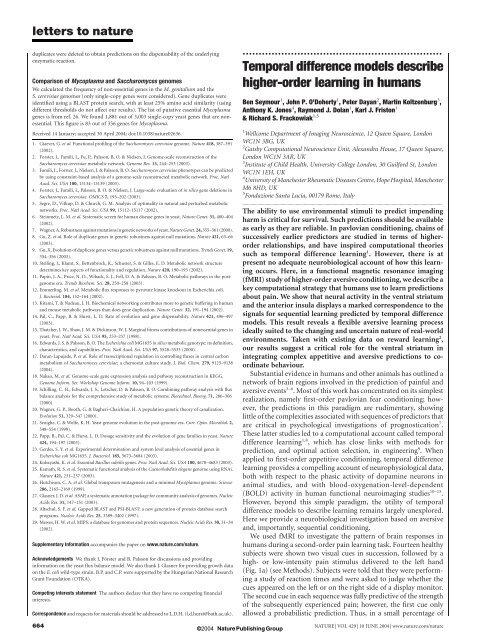
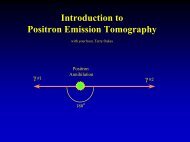
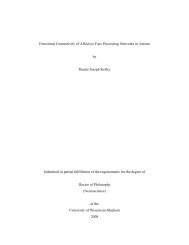
![[F-18]-L-DOPA PET scan shows loss of dopaminergic neurons](https://img.yumpu.com/41721684/1/190x146/f-18-l-dopa-pet-scan-shows-loss-of-dopaminergic-neurons.jpg?quality=85)
